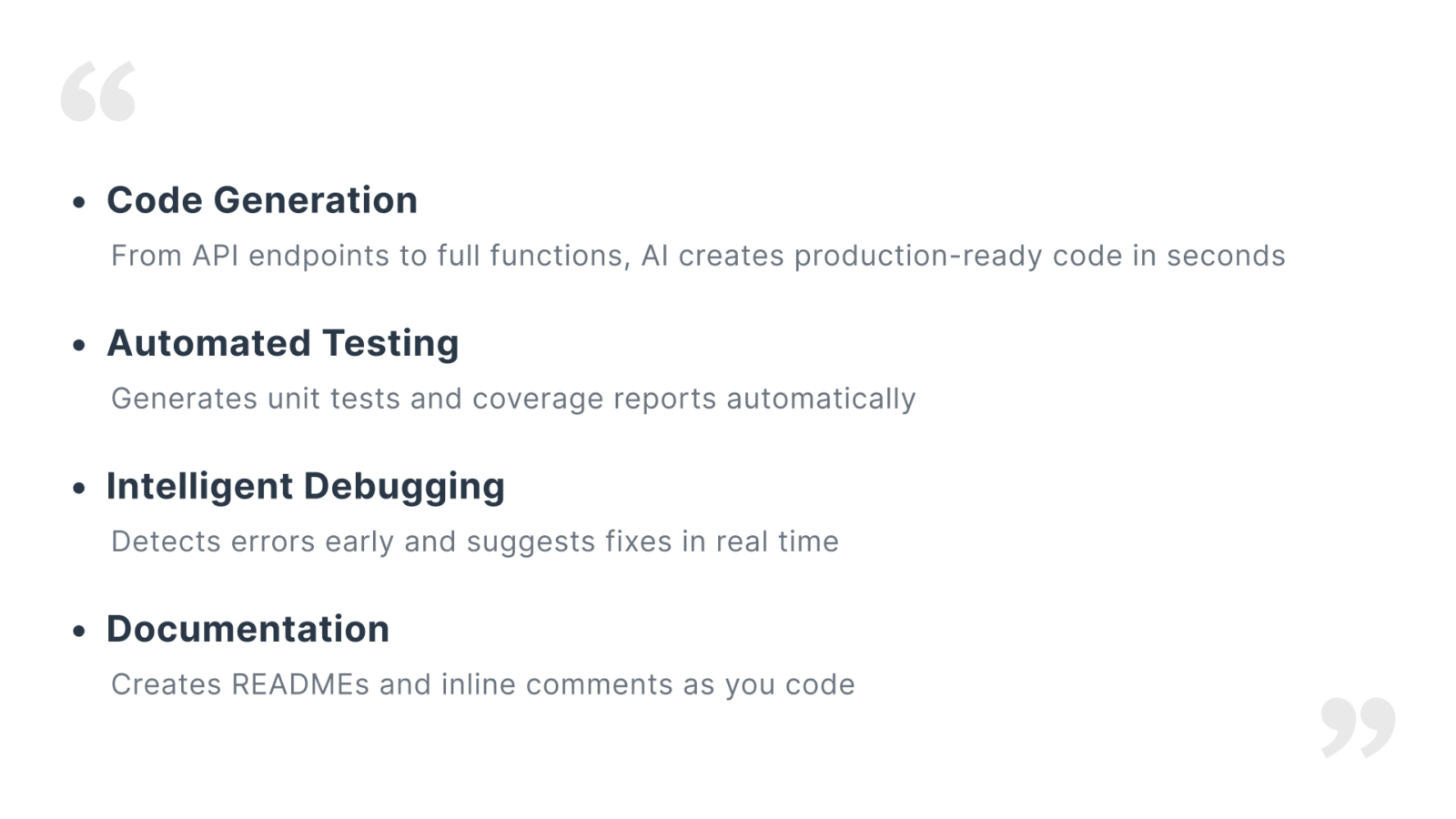AI-assisted developers deliver 30% faster

In modern software development, speed is everything. Businesses compete to launch features faster, respond to user feedback quickly, and stay ahead of industry trends. But traditional development workflows often struggle to keep up. Manual coding, repetitive testing, and lengthy review cycles can slow teams down and delay product launches.
That’s where AI-assisted development changes the game. By combining human expertise with powerful AI tools, developers can work smarter, not harder. Tasks that once took hours now take minutes. Testing becomes automated. Documentation writes itself. Debugging is faster and more accurate.
As a result, development teams deliver projects up to 30% faster without sacrificing quality. In this article, we’ll explore what makes this possible, why AI-assisted developers are the future, and what this speed means for your business.
What Does “AI-Assisted Development” Mean?
AI-assisted development is a new approach to building software where developers use artificial intelligence tools to speed up coding, improve quality, and reduce repetitive work. It’s not about replacing developers; it’s about giving them superpowers.
Instead of spending hours writing boilerplate code or manually creating tests, developers can now rely on AI tools that generate solutions instantly. For example:
- GitHub Copilot suggests entire code snippets as you type.
- ChatGPT explains complex logic and helps with debugging.
- Tabnine and Amazon CodeWhisperer assist with coding patterns and API integrations.
Key Functions of AI in Development:

Unlike basic automation, AI tools learn from context (your coding style, project structure, and even business rules), making their suggestions accurate and relevant.
The Main Factors Behind 30% Faster Delivery
AI-assisted development accelerates the software lifecycle by removing the slow, repetitive tasks that drain time from your team. Here’s how these tools help developers deliver up to 30% faster without compromising quality:
1. Faster Coding
AI-powered tools can generate entire blocks of code in seconds. Need a REST API endpoint, database query, or validation logic? Instead of writing line by line, developers simply provide a short description, and AI generates the solution.
Impact: Up to 20–25% time saved during coding.
Example: Writing a complex API controller manually might take 2 hours—AI does it in under 10 minutes.
2. Smarter Testing
Testing is critical but time-consuming. AI automates much of this process by generating unit tests, detecting coverage gaps, and even predicting edge cases.
Impact: QA efforts reduced by 40%, speeding up CI/CD pipelines.
Example: Automated test generation replaces hours of manual work in regression testing.
3. Quick Debugging
Finding and fixing bugs traditionally requires scanning through logs and code. AI speeds this up by suggesting possible fixes as soon as an error appears.
Impact: Debugging time reduced by 20–30%.
Example: Instead of searching Stack Overflow for solutions, developers get context-aware suggestions instantly.
4. Better Documentation
Developers rarely enjoy writing documentation, but it’s essential. AI auto-generates comments, READMEs, and API documentation as you code, keeping everything up-to-date with zero extra effort.
Impact: Eliminates hours spent on documentation, accelerating delivery without sacrificing clarity.
These improvements result in shorter release cycles, lower costs, and higher developer productivity without cutting corners on quality.
Real Examples of Speed Gains
AI-assisted development has proven impact across real-world projects. Here are two standout examples from Valletta Software’s portfolio that show how AI tools drive speed and efficiency:
Example 1: Backoffice Platform for E-Commerce Logistics
For a growing e-commerce logistics client in Ireland, Valletta Software built a secure backoffice MVP from scratch using .NET Core and Angular. By adding AI tools for code generation and automated testing:
- The team delivered the MVP on schedule, even as requirements grew more complex.
- AI-generated boilerplate and CRUD operations saved up to 25% of development time in core features.
- Automated tests reduced regression cycles, enabling faster deployment of new features.

Example 2: Modular Service Architecture Boosts Productivity
In the same project, the shift to a service-based modular architecture (AccountService, LocationService) became more efficient with AI support:
- Developers used AI to scaffold services and define RESTful endpoints, speeding up API rollout.
- The AI assistance allowed the team to maintain a clean architecture and scale easily as new features were added.
- Feature expansions post-MVP were smoother thanks to AI-generated code and tests, cutting delivery time by 30-40%.
These examples show that AI assistance transforms the entire development lifecycle. From initial architecture to ongoing feature delivery, AI acts as a force multiplier for developer efficiency.
Why Faster Doesn’t Mean Lower Quality
One of the biggest myths about accelerating development is that speed compromises quality. Traditionally, cutting timelines meant skipping tests, reducing documentation, or leaving performance optimizations for later. With AI-assisted development, that’s no longer the case.
AI tools not only increase speed but also enhance quality at every stage:
1. Early Bug Detection and Fix Suggestions
AI-powered code assistants highlight errors and suggest fixes as you type. This reduces the chances of bugs entering the codebase and minimizes costly post-release fixes.
2. Automated Testing Improves Coverage
AI can automatically generate unit tests and even propose edge cases that manual testing might miss. This ensures that quality assurance happens in parallel with coding, not as an afterthought.
3. Code Consistency and Best Practices
AI tools are trained on best practices and industry standards. When writing code, they suggest solutions that adhere to proper patterns, security guidelines, and performance principles.
4. Always-Updated Documentation
Instead of being postponed until the end of the sprint, documentation is generated in real time by AI. This keeps projects maintainable and makes onboarding new developers much easier.
Business Impact of 30% Faster Delivery
Delivering software 30% faster creates real business value. Here’s what this speed means for companies:
1. Faster Time-to-Market = Competitive Advantage
Every extra month before launch is an opportunity for competitors. AI-assisted development shortens release cycles, enabling businesses to launch products and features earlier, capture market share faster, and respond to customer feedback in near real time.
2. Increased Revenue and ROI
When you release faster, you start generating revenue sooner. For subscription-based businesses, this means earlier user acquisition and a stronger market position. For enterprises, it means delivering features customers want before competitors do, increasing retention and upselling opportunities.
3. Lower Development Costs
AI eliminates repetitive tasks, reduces QA time, and lowers the risk of expensive post-release fixes. This leads to 15–25% cost savings per project without cutting quality or hiring additional staff.
4. Happier, More Productive Teams
Developers hate repetitive work. By automating boilerplate coding, documentation, and test generation, AI frees them to focus on strategic and creative tasks. The result:
- Higher job satisfaction.
- Reduced burnout and turnover.
- Better retention of top talent.
AI-assisted development is about delivering more value in less time, reducing costs, and making your team and customers happier.

The Future of Fast, High-Quality Development
Software development is at a turning point. Businesses that continue to rely on traditional workflows risk falling behind, while those embracing AI-assisted development gain a 30% speed advantage without sacrificing quality.
AI doesn’t replace developers; it empowers them. It takes care of repetitive, time-consuming tasks so teams can focus on what truly matters: building innovative products that deliver business value. Faster releases, better quality, happier teams. This is what AI brings to modern development.
The question is no longer if you should adopt AI-assisted workflows; it’s how fast you can start. Because the sooner you implement them, the sooner you unlock speed, efficiency, and competitive advantage.
Ready to deliver 30% faster?
Don’t let your competitors outpace you. Start leveraging AI-assisted development today and transform the way your business builds software.
✅ Cut release cycles by 30%.
✅ Improve quality and reduce bugs.
✅ Lower costs and keep your developers happy.